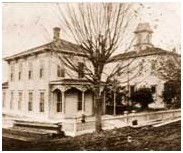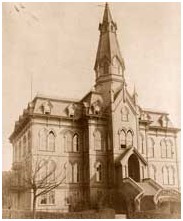
The Early Years ofHoly Names Academy
USINFO | 2014-01-07 16:58
Holy Names Academy was founded in 1880 by the Congregation of the Sisters of the Holy Names of Jesus and Mary. This religious community, guided by the vision of its foundress, Mother Marie-Rose Durocher, was dedicated to providing education for young women, just as the Academy is today. In 1859 the Congregation sent its first sisters to Oregon and, some twenty years later, responded favorably to the request of Father Francis Xavier Prefontaine to establish a school for young women in Seattle. Four sisters, led by Sister Mary Francis Xavier, arrived on November 9, 1880, a date celebrated every year at Holy Names Academy as Foundation Day.
The Academy was first located in two buildings at Second and Seneca Streets. It opened with 21 day students, one boarder and one music student. Within four years the growth of the school and the press of downtown development necessitated the Academy’s move to a new site, at Seventh and Jackson Streets, where a new building was built and dedicated in 1884. By the turn of the century, the growth of both the school and the city once again caused the sisters to consider moving, this time to what was then considered “the wilderness” of Capitol Hill. Under the leadership of their energetic new Superior, Sister Mary Leontine, construction of the present Holy Names Academy was begun in 1906. Bishop Edward J. O’Dea presided at the laying of the cornerstone in 1907 and at the dedication of the school on November 9, 1908, occasions that brought together many members of the community. Mother Martin of the Ascension, Superior General of the Sisters of the Holy Names, came from Montreal, Canada, for the dedication.
The new building, although not quite finished, accommodated all twelve grades and a new Normal School for the training of teachers. Seventeen sisters taught a student body made up of 155 day students and 127 boarders. In 1909, the auditorium was completed, a project given priority so that proceeds from music and drama presentations could be used to fund other work in the building. The chapel was completed in 1925, the music department in 1929, and the underground tunnel, now used for locker space, in 1948. The school’s elevator, one of the oldest in Seattle and recently renovated, was installed in 1931.
The Academy’s imposing architecture, designed in the neo-classical style by Albert Breitung, has been carefully preserved over the years. Few exterior changes have occurred other than the removal of the north tower sometime after a 1965 earthquake, and the addition in 1990 of a new gym––which so closely resembles the original building that visitors often think it has been in place for much longer. Inside the main building, however, educational needs have prompted a number of changes. On its way to becoming a four-year college preparatory school for girls in grades 9 through 12, HNA closed the Normal School in 1930, the grade school in 1963, and the boarding component in 1967. These and other programmatic developments allowed for the construction of new classrooms and offices from a network of smaller rooms, and for the networking of the entire building to support technology. Renovations have always been respectful of the school’s history; for example, new moldings and floors match the originals throughout the building, and the old laundry chutes now house computer cables and telephone wires.
 |
 |
| Second and Seneca | Seventh and Jackson |
The new building, although not quite finished, accommodated all twelve grades and a new Normal School for the training of teachers. Seventeen sisters taught a student body made up of 155 day students and 127 boarders. In 1909, the auditorium was completed, a project given priority so that proceeds from music and drama presentations could be used to fund other work in the building. The chapel was completed in 1925, the music department in 1929, and the underground tunnel, now used for locker space, in 1948. The school’s elevator, one of the oldest in Seattle and recently renovated, was installed in 1931.
The Academy’s imposing architecture, designed in the neo-classical style by Albert Breitung, has been carefully preserved over the years. Few exterior changes have occurred other than the removal of the north tower sometime after a 1965 earthquake, and the addition in 1990 of a new gym––which so closely resembles the original building that visitors often think it has been in place for much longer. Inside the main building, however, educational needs have prompted a number of changes. On its way to becoming a four-year college preparatory school for girls in grades 9 through 12, HNA closed the Normal School in 1930, the grade school in 1963, and the boarding component in 1967. These and other programmatic developments allowed for the construction of new classrooms and offices from a network of smaller rooms, and for the networking of the entire building to support technology. Renovations have always been respectful of the school’s history; for example, new moldings and floors match the originals throughout the building, and the old laundry chutes now house computer cables and telephone wires.
Share this page



















